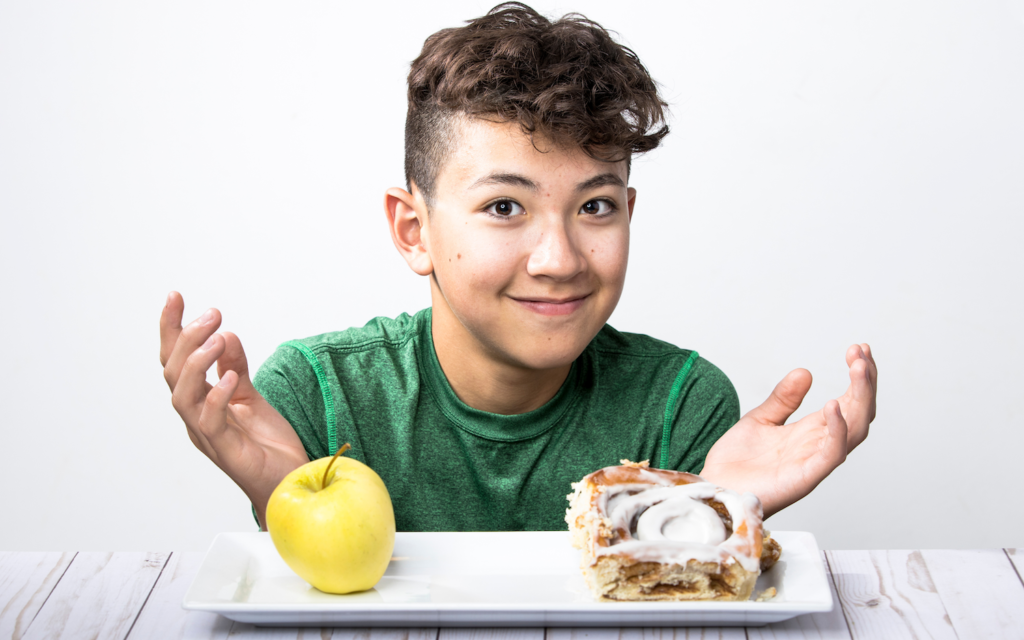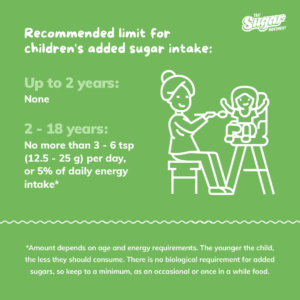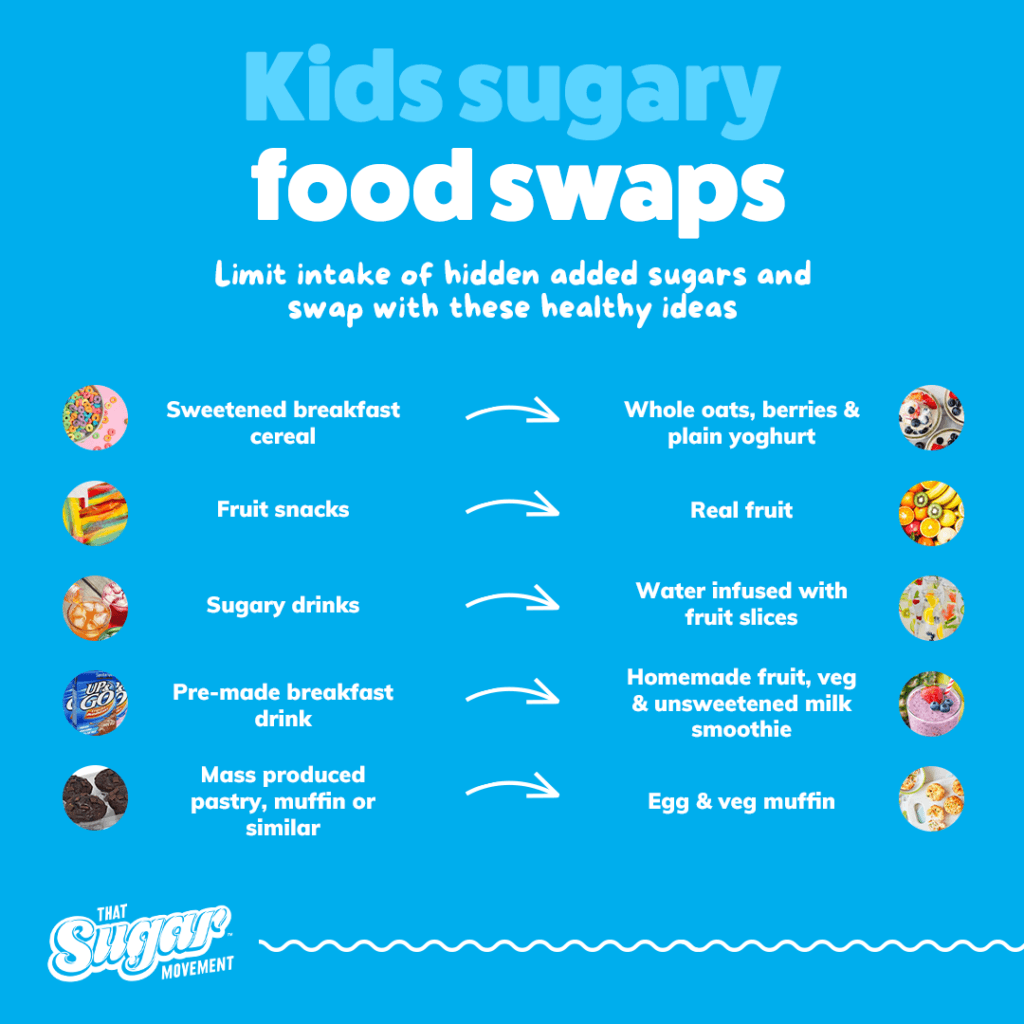Blog
Swapping out kids sugary stuff

Life is busy. We get it. To get through, it is common to lean on ready-made, packaged foods to feed ourselves and our tribe.
While such products are fine in small amounts, we want whole and minimally processed foods to make up the majority of the diet.
The reality is, despite fancy packaging and hyper-appealing tastes, most of these ultra-processed products do not serve health, often loaded with unhelpful ingredients, including added, free sugars.
As children grow, healthy meals are important for nourishing their brains and bodies, while laying the foundation for positive eating habits in the future.
The good news? Once you get into the swing of things, creating healthier food options, without added sugar, might be easier than you’d think.
Sugar and kids
A little added or free sugar is okay for most. It is recommended to limit daily intake to 5% of total energy intake. For kids over 2-years-old, this roughly translates to 3-6 teaspoons per day, depending on age and energy requirements.
The younger the child, the less they should consume. For those under 2, it is advised they don’t have any at all.

Why is it important our kids limit intake of the sweet stuff, as well as the ultra-processed, packaged products it often comes in?
Too much increases the risk for nutritional insufficiencies, tooth decay, type 2 diabetes, obesity (and its related health conditions), heart disease, and more.
To limit intake of added sugars and increase intake of healthful foods, here are some common sugary, ultra-processed products and our suggestions for simple, nourishing, whole food alternatives!
Sugar swaps for kids
Breakfast cereal
Despite what the advertisements tell you, many ready-made cereal products do not set up kids for success. Being sugar-laden and composed of highly-refined, high GI sources of carbohydrates, they supply a quick burst of energy that will not adequately sustain them for the day ahead.
Swap with:
Meals with sources of fibre, healthy fat, protein, and other nutrients, providing a steady supply of energy to keep them powering on, such as:
- A combination of whole oats, seasonal/favourite fruits, a sprinkle of sunflower or chia seeds, and a dollop of plain, unsweetened full-fat yoghurt makes a nourishing breakfast for kids. Served up as a porridge, overnight oats, or granola. Have a play and adjust according to your child’s preferences.
- A savoury breakfast, such as an egg slice or frittata that includes spinach, peas, and tomato, or egg, bacon, and greens muffins.
Quick-fix breakfasts
Ultra-processed products such as breakfast biscuits, bars, liquids, and shakes are often high in added sugars. As with sweetened ready-made cereals, the onslaught of sugar from these seemingly healthy foods results in a quick spike then crash in energy. This makes it difficult to concentrate, learn, and maintain a stable mood.
Swap with:
- A homemade smoothie. This is an easy meal to whip up that packs in a lot of nutrition if composed of the right ingredients. Think unsweetened milk (dairy or alternative), banana, berries, a dollop of unsweetened yoghurt, some baby spinach, finished with a little 100% nut spread, a few almonds, cashews, or whole oats.
- Pre-prepared breakfasts, such as egg frittata or overnight oats. Each can be made in bulk, then stored in the fridge, ready to go.
Fruit snacks – strings, rolls, and strips
Sticky and tacky, fruit snacks, such as strings, rolls, and strips, often contain added sugars or fruit concentrates. When that stuff gets stuck to the teeth too often, we are set for a trip to the dentist.
Swap with:
- Real fruit. When paired with plain yoghurt, nuts, seeds or 100% nut spread, and you have a tasty, sustaining, healthy snack for kids.
- Blended, baked, or roasted goodies. Prepare a stash in advance, such as nutty banana bread balls, nut butter cookies, or roasted chickpeas.
A note on dried fruit. Keep dried fruit, such as sultanas or dates, to a minimum. If having, ensure it is unsweetened, and pair with a source of protein or healthy fats, such as nuts and seeds.
Sugary drinks
Quick delivery of liquid free sugars will send your kid’s energy sky-rocketing, only to plummet a short time later. Long-term, such drinks increase risk for dental caries, type 2 diabetes, heart disease, obesity, fatty liver and other issues.
Sugary drinks include soft drinks, juices, fruit drinks, flavoured milk and water, sports drinks, and energy drinks. Energy drinks in particular are a no-go zone for kids.
Swap with:
- Water, water infused with whole pieces of fruit and herbs such as berries, lemon, apple, and mint, or unsweetened milk or alternative.
A note on fruit juice. While fruit juice is considered a free sugar, if having, serve only a little, choose 100% (ideally freshly squeezed), and water it down.
Refined, white flours
Pasta, bread, cakes, muffins, and pastries – there are better and worse options for these foods.
Whether ready-made or from a packet, it is the ultra-processed nature of many of these products, including ingredients such as added sugars and highly refined white flour, that is not ideal.
Commonly the foundation for many meals in the Western diet, the highly refined flour used in foods such as white bread and pasta has been transformed from a complex carbohydrate – the whole grain – into a simple carbohydrate. Simple carbohydrates, including added, free sugars, are quickly absorbed into the bloodstream and lack the goodness its whole grain counterpart may offer.
Swap with:
Whole foods, including vegetables, fruit, legumes, and whole grain alternatives. Active kids can burn through carbohydrates quickly, but whole foods should be the source of this energy over the processed white stuff.
Whole foods come packaged with fibre and other beneficial nutrients to lessen the impact on the body, slowing the absorption of naturally occurring sugars, resulting in a more gradual and stable source of fuel.
For healthy alternatives to a sugary slice, cake, pastry or white bread, consider:
- Veggie fritters, lentil balls, or an egg and veggie muffin for an easy-to-pack-into-a-lunchbox delight! Each of these supply vegetables and protein, provide longer lasting energy, and help support growth.
- Dips and veggie sticks, such as hummus and cut carrots, capscium and cucumber
- Our buckwheat blinis. A handy alternative to baked goods, made more nourishing topped with plain yoghurt or 100% nut spread.
- Wholemeal pasta, and wholemeal, seeded, and/or sourdough breads or wraps. If opting for a sandwich, choose the least processed, most nutrient-dense bread or wrap option, and ensure the fillings offer a source of healthy fats and protein, such as avocado, 100% nut butter, cheese or egg.

Other things to consider:
- Make changes gradually, so not to feel overwhelmed. Change one meal or snack at a time.
- Consider what you and the kids eat in the context of the whole diet. A little added sugar and ultra-processed food won’t break the health bank!
- It is okay for your kids to have an occasional serving of white pasta/flavoured yoghurt/a bickie/a little chocolate or any other ready-made or ultra-processed food. We aren’t saying to abstain altogether; they just don’t need to have these all day every day, as they displace important nutritious whole foods.
- Keep an eye out for the many names of sugar in the ingredients list, and remember the higher up the ingredients list, the more sugar is in that product. While present in the obviously sweet stuff, added sugar hides in our everyday, seemingly healthy foods.
- Keep sugary drinks and ultra-processed packaged products either out of the house or to a minimum.
After more kids meal ideas? We’ve plenty of healthy recipes for the whole family and inspiration for whole food ideas in our books, e-books and recipes on our website. Check out our healthy meal ideas for kids, too!
Enjoy getting creative when improving the eating habits of your kids and finding better whole food alternatives. It may be a little tricky at first, but tackle the changes one food item at a time – it will be worth it!
By Angela Johnson (BHSc Nut Med)











